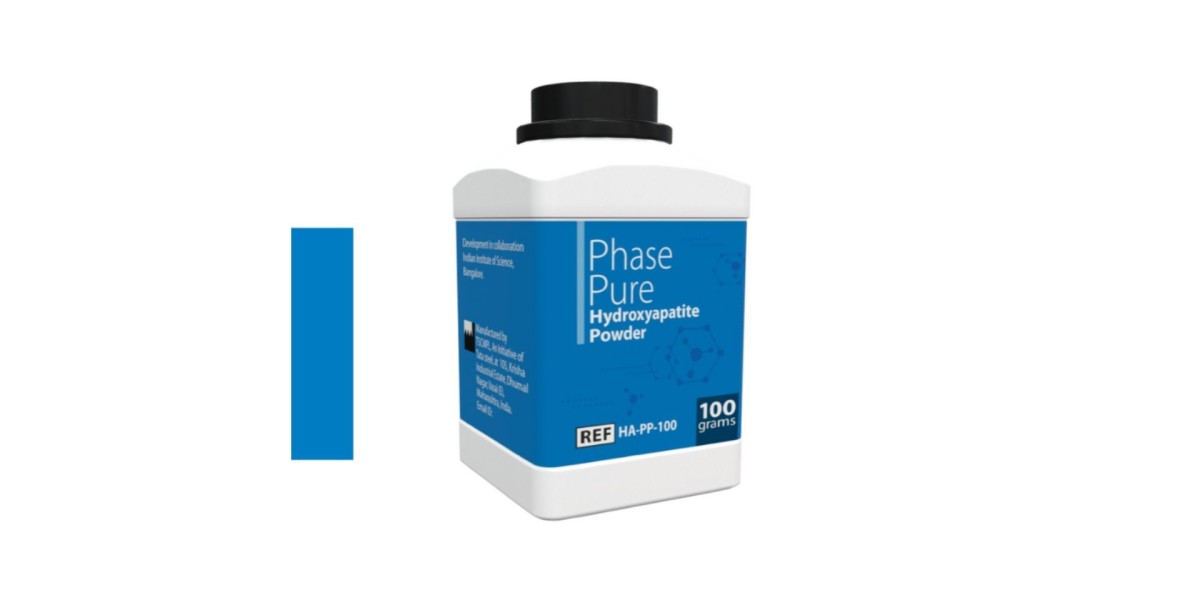Hydroxyapatite powder has attracted significant attention across a range of areas, from biomedical research to dental health due to its distinctive properties that are similar to the mineral components found in human teeth and bones. This article is designed to give the most complete knowledge of hydroxyapatite powder's properties as well as its composition, benefits of its applications, as well as its role in contemporary technology and science.
Understanding Hydroxyapatite: Composition and Structure
Hydroxyapatite occurs naturally as a minerals form of calcium apatite, with its chemical formula Ca5(PO4)3(OH), frequently referred to by the name of Ca10(PO4)6(OH)2 to reflect its crystal structure. It is a major element of human bones and teeth, comprising around 70 percent of bone mineral, and 90 percent of tooth enamel. The similarity in biological structures renders hydroxyapatite extremely useful in dental and medical applications.
Hydroxyapatite crystals have hexagonal shapes, and their shape permits them to easily interact and with living tissues encouraging cell adhesion as well as growth. The biocompatibility and biocompatibility of the hydroxyapatite powder is among the main reasons behind its widespread application in dentistry, orthopedics and bioceramics..
The Production of Hydroxyapatite Powder
Hydroxyapatite powder is made using a variety of techniques that include chemical precipitation that is wet process, hydrothermal, and sol-gel methods. Each process affects the properties of the powder like particle size, purity and crystallinity. These are essential for specific uses.
Wet Chemical Precipitation It is by far the most commonly used method to make hydroxyapatite. It involves mixing phosphate and calcium sources in controlled temperature and pH conditions. The resultant precipitate is then filtered cleaned, washed, then crushed to produce the pure powder of hydroxyapatite.
Hydrothermal process: In this method it is made by hydroxyapatite at high temperatures and pressure generally using an autoclave. This produces a highly pure and crystal-clear form of hydroxyapatite. This makes it perfect for biomedical research.
Sol-Gel Method: This method involves the transformation of the solution into gel. The gel is later dried and then calcined. Sol-gel techniques allow for exact control of the composition of chemicals and the microstructure of hydroxyapatite.
Applications of Hydroxyapatite Powder
Hydroxyapatite powder is used in a broad variety of applications in a variety of areas due to it's biocompatibility and bioactivity and its resemblance to tooth and bone minerals.
1. Biomedical Applications
In the biomedical area it is commonly utilized to aid in bone implant grafting, coatings of implants in addition to drug delivery methods.
Bone Grafting Hydroxyapatite powder can be used as a substitute for bone grafts because of its capacity to help bone cells attach and growth. It functions as a scaffold that aids in the growth of bone tissue, and then being substituted by natural bone.
Implant coatings Implants specifically made from metals, such as titanium, are typically coated with hydroxyapatite in order to improve their biocompatibility. The coating helps promote osseointegration, where the implant forms a direct bond with bone, thus reducing the chance of failure.
Drug Delivery Hydroxyapatite's porous nature makes it suitable as a drug carrier especially in specific delivery systems. It is engineered to release drugs in a controlled manner and improve the effectiveness of treatment for bone-related disorders.
2. Dental Care
Hydroxyapatite powder plays an important part in the creation of dental products, including dental floss, toothpaste as well as the fillings for dental cavities.
Mouthwash and Toothpaste: Hydroxyapatite is a important ingredient in remineralizing toothpastes and mouthwash. It aids in restoring the enamel's mineral content by repairing tiny dental lesions, and also reducing the sensitivity of teeth.
dental fillings In order to ensure its compatibility with tooth structures the hydroxyapatite is used in dental fillings and for restorations. It helps to promote the natural healing process of dentin and enamel which results in the most natural and durable restoration.
3. Bioceramics and Tissue Engineering
In the bioceramics field and the field of tissue engineering, hydroxyapatite is used to construct scaffolds to aid in osteoblast regeneration. These scaffolds aid in cell attachment and growth and provide a platform for the development of new tissue.
Bioceramics Hydroxyapatite-based ceramics can be utilized to make a variety of medical devices, such as osteoporosis and prosthetics. Their bioactive nature facilitates the fusion of the device with bone tissue.
Tissue Engineering Hydroxyapatite scaffolds are vital in the field of tissue engineering to regenerate bones along with other types of tissues. They are temporary structures that cells can stick to, expand, and then eventually replace by natural tissue.
The Advantages of Hydroxyapatite Powder
The distinctive properties of hydroxyapatite powder makes it a valuable material for numerous applications. Some of the main advantages are:
biocompatibility Hydroxyapatite has been found to be highly biocompatible which reduces the risk of adverse reactions and encouraging healing.
Bioactivity This helps in the development of tooth and bone structures, which makes it a great choice for dental and medical use.
Multi-purpose: Hydroxyapatite powder can be utilized in a variety of ways for coatings, such as scaffold or filler according to the purpose.
Non-toxic: Hydroxyapatite has no toxic effects and has no negative effects when it is used in the body. This makes it an ideal choice for dental and medical products.
Future Prospects of Hydroxyapatite Powder
The future for the hydroxyapatite powder appears promising, thanks to continuing research and development that aims towards improving its properties as well as expanding its use. The advancements in nanotechnology as well as material science and Regenerative health should increase up the need for hydroxyapatite in innovative ways.
Nanotechnology the development of tiny hydroxyapatite particles opens up new possibilities for the delivery of drugs as well as bone regeneration and dental treatment. Nanoparticles provide enhanced bioactivity and greater interactions to biological tissue.
Regenerative Medicine: Hydroxyapatite's role in regenerative medicine is set to grow as new techniques for stem cell therapy develop. Its capacity to aid in the growth of cells and to aid in tissue regeneration makes it an essential substance in this area.
Materials Science The research into improving the properties mechanical of hydroxyapatite including its toughness and strength is in progress. This could lead to novel applications in load-bearing implant and other environments with high stress.
Conclusion
Hydroxyapatite powder is an amazing material with a broad range of uses in dentistry, medicine and even beyond. Its resemblance to the minerals found in teeth and bones, together with its biocompatibility and bioactivity makes it a vital component of the modern world of research and industry. When research and innovation continues the possible uses for the hydroxyapatite powder will increase, bringing new ways to improve overall health and wellbeing of the human body.



